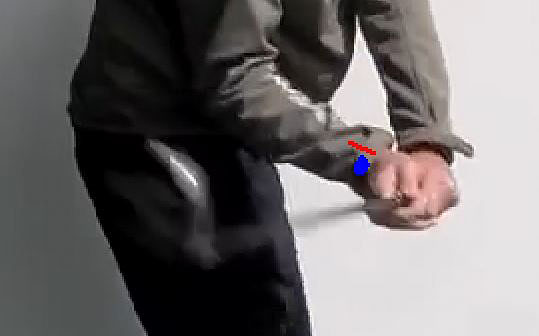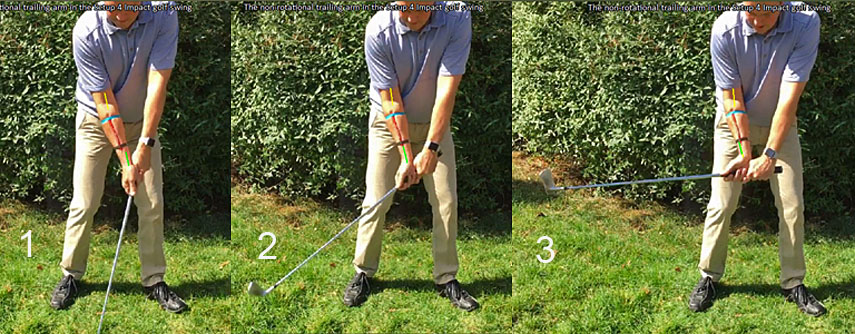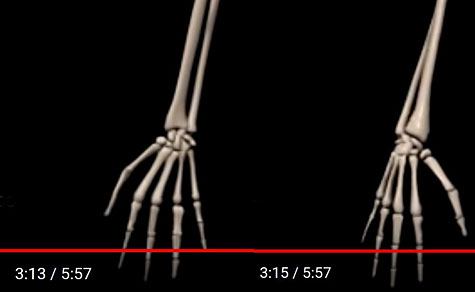|
|
Post by dubiousgolfer on Sept 8, 2018 17:25:39 GMT -5
Fantastic analysis Dr Mann - many thanks.
|
|
|
|
Post by imperfectgolfer on Sept 10, 2018 23:56:29 GMT -5
Kirk Junge has produced another video in at attempt to demonstrate that the right forearm does not supinate in his backswing action or pronate during his downswing action. He has taped a pencil to his right mid-upper forearm and he uses that pencil to imply that the right forearm does not rotate during his backswing/downswing action - because the pencil does not rotate relative to the right antecubital fossa. However, that's a major demo-mistake because one would not expect the right mid-upper forearm to change its rotational alignment relative to the right antecubital fossa during a right forearm supination/pronation motion. He should be looking at the radial bone just above the right wrist crease and the watchface area of his right forearm 1" above the back of his right hand. Here is a capture image from his video.
The pencil's alignment relative to the right antecubital fossa may not have changed at this P3 position from a rotational perspective, but it's very likely that the watchface area of his right lower forearm is rotated more clockwise relative to the pencil due to a small amount of right forearm supination. The amount of right forearm supination present in that image is expected to be very small because his right palm is parallel to a steeper plane (probably the TSP) at his P3 position.
However, consider the situation at his P5.5 position in his "real life" golf swing action. Image 1 is at the P5.5 position. Here is a closeup view of his right lower forearm at that P5.5 position.  I have painted a blue dot over the watchface area of his right lower right forearm and I have drawn a red line over his radial bone 1-2" above his right wrist crease. It is obvious that they are rotated more clockwise than the right antecubital fossa and that is due to right forearm supination. Note that at impact (image 2 of the next close-up view of his downswing's impact image) that the blue dot area and red line are rotated far less clockwise relative to the right antecubital fossa and that means that right forearm pronation happened between image 1 and image 2 of this next close-up view of his downswing series of capture images.
I would recommend that Kirk Junge view the following video in order to note how the distal (peripheral) forearm rotates much more than the proximal (central) forearm during a pronation-supination motion.
Here are capture images from the video showing how the amount of forearm rotation is much greater at the level of the radio-carpal joint area relative to the mid-upper forearm.
Jeff.
p.s. I posted the following comment in the comment section under Kirk Junge's video-: " I think that you are making a major mistake in that video by taping the pencil to the middle of your right forearm because it will not change its positional alignment relative to the right antecubital fossa during a right forearm supination/pronation motion. You should be looking at the radial bone 1" above the right wrist crease and the watchface area of the right lower forearm - as described in a post in this thread at newtongolfinstitute.proboards.com/thread/660/rotation-left-forearm-right?page=2&scrollTo=8946 " and I don't know if he has blocked that comment's appearance in the comment section, or not. |
|
|
|
Post by dubiousgolfer on Sept 11, 2018 16:52:21 GMT -5
Dr Mann - I can still see your comments, although I don't think Kirk wants to repeat the demo using different alignment positions.
DG
P.S. I tried recreating Kirk's demo and could restrict the supination of the right forearm in the backswing but only if I pulled in my right elbow (ie. extending my right humerus) behind my shirt seam while it was folding. It felt very restricted in my backswing and I couldn't load PA4 fully. I remember trying Kirk's swing technique several years ago and just couldn't get much distance or consistency, plus my back started to ache (don't know why) so gave up on it after a few months.
|
|
|
|
Post by imperfectgolfer on Sept 11, 2018 20:26:06 GMT -5
Dr Mann - I can still see your comments, although I don't think Kirk wants to repeat the demo using different alignment positions. DG P.S. I tried recreating Kirk's demo and could restrict the supination of the right forearm in the backswing but only if I pulled in my right elbow (ie. extending my right humerus) behind my shirt seam while it was folding. It felt very restricted in my backswing and I couldn't load PA4 fully. I remember trying Kirk's swing technique several years ago and just couldn't get much distance or consistency, plus my back started to ache (don't know why) so gave up on it after a few months. I strongly suspect that Kirk will not want to repeat the demo video using your suggestions. You are correct that it is possible to avoid right forearm supination if you place your right elbow behind your right shirt seam in a punch elbow position. However, how is it possible to avoid having a supinated right forearm if your right elbow is in a pitch elbow position and your right palm is under the club handle and significantly facing the sky - as seen in the following P5.5 image.
Here is my latest comment to Kirk I that I recently posted in his comment section of his video. "Kirk,
I disagree with your assertion that you are not rotating your right forearm during that demonstration.
Here are capture images from the 3:51-3:54 minute time point of your video.

Image 1 is at address. I have drawn a yellow line down the middle of your right antecubital fossa and I have drawn a green line over the radial bone just above the right wrist crease. Note that the yellow line and green line are straight-line-aligned.
Image 2 is when your start to bend back your right wrist and when you start to pronate your left forearm. Note that the green line has moved slightly to the right of the yellow line - due to a clockwise rotation of the right radio-carpal joint relative to the right antecubital fossa.
Image 3 is at the end of your takeaway when the clubshaft is parallel to the ground (P2 position when the toe of your club is pointing up). Note that your left forearm has pronated so that the back of your left hand faces the camera. Also, note that the green line has moved to the right of the yellow line (and even to the right of the pencil attached to your right forearm) and that is due to a clockwise rotation of your right forearm. It cannot be due to any motion of your right humerus (which you have kept stationary) or due to any increased bending at the level of your right elbow (which you are avoiding).
Here is a close-up view of image 3.

Note that the green line is rotated clockwise relative to the yellow line, which means that the right forearm is more supinated at the P2 position than it was at address. Secondary proof can be derived from looking at the ventral aspect of your right forearm just above your right wrist crease - which I have painted over with a faint red color stain (using Photoshop). How is it physically possible that one can see so much of the ventral aspect of your right lower forearm if you have not rotated your right forearm in a clockwise direction relative to its address alignment (when one cannot see the ventral aspect of your right forearm)? Note that the watchface area of your right lower forearm is hidden from view at the P2 position because it is facing inwards towards your right thigh. However, at address, the watchface area of your right lower forearm is partially visible and it is facing directly away from the target and not inwards towards your right thigh. What can explain that changed alignment of the "watchface area of your right forearm" other than the fact that your right forearm has rotated clockwise more between address and the P2 position - which means that it is more supinated at the P2 position than it is at address?
In this NGI forum thread ( newtongolfinstitute.proboards.com/thread/660/rotation-left-forearm-right?page=2 ) I posted the following capture images from your "real life" downswing.

Image 1 is at the P5.5 position and image 2 is at impact. I have painted a blue dot over the watchface area of your right lower forearm and a red line over the radial bone just above your right wrist crease. In image 1 - note that the blue dot is facing inwards towards your right thigh and note that the red line is rotated more clockwise than your right antecubital fossa, which means that your right forearm must be supinated. How can your right forearm not be supinated in that image if you have a pitch elbow position of your right elbow where your right elbow is closer to the target than your right hand - but your right palm is under the club handle and it is facing significantly skywards? I don't believe that it is biomechanically possible to get your right palm to be aligned so horizontally (under the club handle) if your right forearm was not significantly supinated. Look at image 2 (impact alignment) where the watchface area (blue dot area) of your right forearm is not facing inwards towards your body and where is it facing directly away from the target and where the red line over the radial bone is now more closely aligned with your right antecubital fossa (from a rotational perspective). How is that alignment possible if you did not pronate your right forearm between image 1 and image 2?
Here is a you-tube video on pronation-supination motions
Here are capture images from that video.

The left-side image shows a supinated right forearm, and I believe that the left-side image represents your P5.5 position (as seen in image 1 above). The right-side image shows a more pronated right forearm, and I believe that it represents your impact image position (as seen in image 2 above).
Jeff.
|
|
|
|
Post by imperfectgolfer on Sept 12, 2018 7:01:54 GMT -5
Here is Kirk's reply to my post-: " You had to choose where to draw your lines and did so to try and prove your point. The lines you made did not move as they should due to camera position like the pencil that was attached to my arm. I explained in the beginning of the video about camera angles. You also chose to ignore the part about 5 seconds later in the video where I showed only the club opening and closing with no rotation in the trailing arm. Something you said was impossible. I am certain that you would even argue with 3D results so I will not waste my time any further as the whole point I am making has been ignored by you. Which was that there is no pronation necessary to square the clubface at impact as I setup with the arm in a position (non-rotational) where it does not need to pronate, and if it did I would hit the ball to the left." Here is my rebuttal reply-: " Of course I had to choose where to draw the line along the radial bone just above the right wrist crease and the line down the middle of the right antecubital fossa, but that doesn't mean that they are not accurately reflective of reality. You could easily replicate the accuracy of my results by repeating your demo using markers placed at those positions, but I would not be surprised if you do not take up that challenge because it would force you to intellectually come to terms with your "alternative facts" approach to golf swing biomechanics. I did not ignore the part 5 seconds later in the video because your trailing arm rotated exactly the same as shown in my images. The only time that your right forearm didn't rotate was when you performed an one-piece takeaway at the start of the video. I am not at all surprised that you did not address my assertion that it is biomechanically impossible to have a non-supinated right forearm in the following image of your "real swing" when you are at the P5.5 position. perfectgolfswingreview.net/JungeP55.jpg
I guess that we live in the Trumpian world where there is no "truth" when it comes to golf swing biomechanics, and there are only "facts" and "alternative facts".
Jeff. |
|